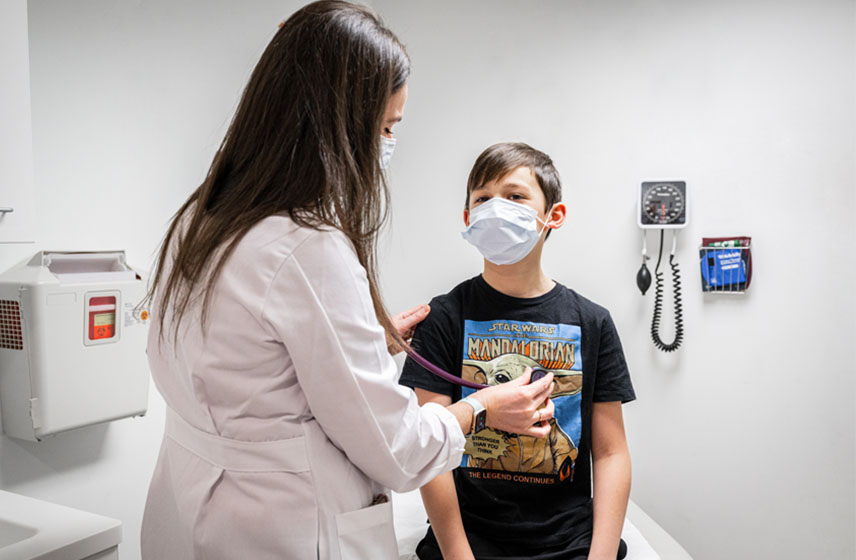Aortic valve stenosis is most likely not what you were expecting. You probably have a million questions and worries. What does this even mean? Can they still run and play? Will they need surgery? Where can they get the best care?
Cleveland Clinic Children’s compassionate pediatric cardiologists (heart specialists) and other healthcare providers are here to help your child and answer your questions. They have years of experience safely and effectively treating children’s heart problems like aortic valve stenosis — from infancy into young adulthood.
Why Choose Cleveland Clinic Children’s for Aortic Valve Stenosis Care?
Skilled collaborative providers:
A highly skilled team of pediatric heart specialists, including expert surgeons, industry-leading cardiologists and other providers work together to give your child the very best care — keeping you in the loop at every step. Meet our team.
National recognition:
Cleveland Clinic Children’s is a trusted healthcare leader. We’re recognized throughout the U.S. for our expertise and care.
Convenient care:
An aortic valve stenosis diagnosis means your child will need lifelong cardiac care. At Cleveland Clinic Children’s, they’ll get leading heart care at every stage. As they enter adulthood, we’ll help them transition seamlessly from pediatric to adult congenital heart disease (ACHD) trained specialists.
Specialized knowledge:
Aortic valve stenosis may happen by itself or with other children’s heart problems. We treat a wide range of complex pediatric heart issues and have the knowledge and experience to personalize your child’s treatment to their needs and health.
Aortic Valve Stenosis Diagnosis at Cleveland Clinic Children’s
Aortic valve stenosis (narrowing of the aortic valve) means blood isn’t flowing through your child’s heart as well as it should. The condition could be mild, moderate, severe or critical.
If the condition is mild-to-moderate, your child may have no symptoms. If your child’s primary healthcare provider hears a heart murmur during a checkup, they may send you to a pediatric cardiologist for more testing.
In severe-to-critical conditions, your child may feel tired, dizzy or even faint. They might have chest pain or heart palpitations (skipped beats). Infants may have trouble feeding.
If we think your child has aortic valve stenosis, we’ll likely order several tests to take a closer look at your child’s heart and see how it’s working. These tests may include:
Providers Who Treat Aortic Valve Stenosis
Locations
We offer treatment for aortic valve stenosis at the following locations in Northeast Ohio.Aortic Valve Stenosis Treatment at Cleveland Clinic Children’s
After going over your child’s imaging results with you, we’ll talk about treatment options. We’ll consider their age, symptoms, medical history and how severe their stenosis is as we craft their treatment plan. Our goal is to provide your child with the safest and most effective treatment possible.
Monitoring
We may recommend keeping an eye on (monitoring) mild-to-moderate aortic valve stenosis. If your child has no other heart problems or symptoms, monitoring may be all they need for now.
This means your child will regularly see our pediatric cardiologist. They’ll do a physical exam and routine imaging to catch any changes in their heart. If we see changes or your child starts having symptoms, we can switch to more active treatment.
Medication
We may prescribe medication to help manage symptoms of aortic valve stenosis and control your child’s blood pressure and heart rhythm. While your child is taking medication, we’ll watch them closely for side effects and see how well the medicine is working.
Balloon dilation of the aortic valve
Sometimes, your child may need a heart procedure to treat the problem and help them feel better. A balloon valvuloplasty (dilation) of the aortic valve can improve blood flow through it. Your child will be asleep and won’t feel any pain during this minimally invasive procedure. Your child’s surgeon will:
- Make a small incision (cut) in your child’s groin.
- Insert a catheter (small, hollow tube) through their blood vessel and guide it to their narrowed aortic valve.
- Inflate a small balloon on the catheter’s tip, opening their heart valve to increase blood flow through the valve.
- Remove the catheter and close the incision.
Valve replacement surgery
We may recommend aortic valve replacement if the stenosis is severe or critical. While your child is under anesthesia, the surgeon makes an incision in their chest, removes their aortic valve and replaces it with a new one.
Your child’s new aortic valve is either a biological valve (from human or animal tissue) or a mechanical valve. We talk about the benefits and drawbacks of each valve type and help you make the best choice for your child.
Another type of aortic valve replacement surgery is the Ross procedure. During this surgery, we’ll replace your child’s aortic valve with their healthy pulmonary valve and implant a donor valve where their original pulmonary valve used to be.
Taking the Next Step
Aortic valve stenosis will reshape your child’s life — and yours. This condition will mean they need to have lifetime cardiac care and management, from diagnosis through adulthood. At Cleveland Clinic Children’s, we’re here to make that happen as easily as possible. Our specialists will repair your child’s heart and work with you to design a personalized treatment plan that supports and changes with them as they grow and develop.
Appointments
Getting an appointment with Cleveland Clinic Children’s aortic valve stenosis experts is easy. We’re here to help your child get care.
Billing & Insurance
Manage your Cleveland Clinic account. Find billing information and financial assistance, plus FAQs.
MyChart
Securely access your personal health information at any time, day or night.





